10 Things you will only see in Nepal
It won’t be necessary to say that Nepal is rich in geographical diversity and natural magnificence with the possibility of encountering some of the rarest species in the wildlife. The country which is also known as birthplace of influential personalities like Gautam Buddha, Sita, Bhrikuti and Araniko is also known for some of its records that include eight out of ten highest peaks in the world along with Mount Everest, the highest peak.
While the vegetation may spread, records may break, recipes may change and the cultures may get influenced with time, there are some things that you will only see or find in Nepal.
The National flag, with unique proportions and symbolism

Known as the world’s only non-quadrilateral flag, Nepal’s flag easily catches the eye among the other rectangular flags. A combination of blue borders around the overlapping red right triangles, with celestial bodies – sun and moon, the flag first appeared when Prithvi Narayan shah unified all small principalities of Nepal.
The colors used in flags- red signifies the bravery, blue signifies harmony and peace while white signifies purity. Similarly, the inclusion of the celestial bodies in the flag indicates Nepal’s permanence and the hope that Nepal will enjoy the same longevity as the Sun and the Moon. The moon in the upper pennant also represents the cool weather of the Himalayas whereas the sun in the lower pennant represents the hot temperature in the lowlands of Nepal.
Mount Everest, the highest peak in the world

At the elevation of 8848 metres, the magnificent peak attracts thousands of climbers every year out of which hundreds reach the base camp, roughly few dozen touch the peak and even less come back. The peak is locally known as Sagarmatha which means ‘Forehead of the Sky’.
While this pride of Nepal and its stories have been made into successful films and documentaries like Everest, The Conquest of Everest, Blindsight and Into Thin Air, the beautiful and alluring mountain also has a bad reputation for the number of deaths it claim every year.
Lukla Airport, Most dangerous airport in the world

The runway in Lukla Airport
Also known as Tenzin-Hillary Airport in Lukla, the airport is at the height of 9325 feet positioned between mountains with a very short runway. The landings can be dramatic and will definitely make you grip your seat-belts if not cry. But the view and the experience is great once you land safely (until you remember you have to fly back), with a story you will repeat at every Thanksgiving and tours.
Popularly known as the gateway to Everest, the airport is listed as the most dangerous airport in the world with more than 300 deaths. While the deaths in Everest are listed separately, some trekkers and mountaineers do not even make it up to the base camp.
Everest Skydive, the life-threatening experience

Till now there were only three ways to see the panoramic view of Everest and the Himalayas surrounding it- in photos and videos, trek to base camp and summiting the peak. Now, there is a crazy addition to the list, with the life-threatening experience of skydiving from more than 23,000 feet above the sea level. Launched in 2008, the Everest skydive is once in a lifetime free-fall experience in the world.
The adventure begins with the start of November every year, where people can choose between a package that includes only skydiving or the 11 days expedition that covers all the expenses from the arrival at the airport to your departure with three jump days at $25,000 only.
Spiny Babbler, the thorny bird

Spiny Babbler, the thorny bird
Native to the middle hills of Nepal, the spiny babbler is locally known as ‘Kande Bhyakur’ with a literal meaning of thorny bird. The shy bird with a soothing tone settles around the subtropical and tropical lands of Nepal and lives in dense scrubs.
Sighted specifically around the Godavari and Phulchoki area of Kathmandu valley, the bird has brown feathers and pointy beak. The bird consumes earthworm, berries, seeds, nectar and fruits found in the forest. Out of more than 800 species of birds that are found in Nepal, Spiny Babbler is an endemic species.
Kumari, Living Goddess
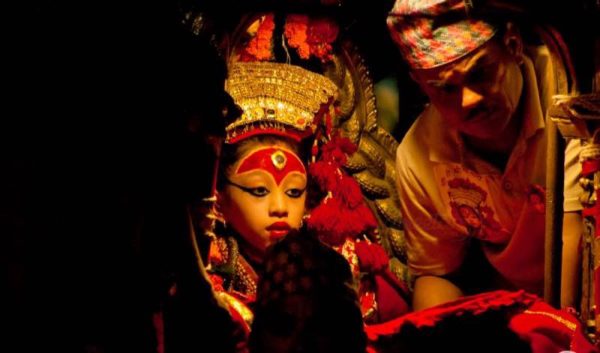
Public appearance of Kumari during Indra Jatra
Influenced by the story of Goddess Taleju and the king in the valley, the holy land still believes in the tradition of living goddess and her power. Kumari, the literal meaning Virgin Goddess, is always chosen from the Shakya clan of Newar community. The young girl must possess 32 perfections which include perfect health with no history of serious illness, unblemished skin, long slender arms, black-straight hair and most importantly she should not have menstruated. It is believed that when a Kumari has her first menstruation, she loses her divine power and so she is returned back to normal life and a new Kumari is chosen.
There are three main Kumaris in the valley, chosen in Bhaktapur, Lalitpur and Basantapur. The kumari chosen in Basantapur is known as the Royal Kumari. The chosen Kumari lives in a separate building, called Kumari Ghar (home) and has to follow certain rules, one of which is her feet should never touch the ground. Dressed in red and gold, with a third eye painted on her forehead, the Kumari appears in the eye of public only on auspicious occasions and festivals like Indra Jatra, Machhendranath Jatra etc.
Tihar, a festival when animals are worshipped
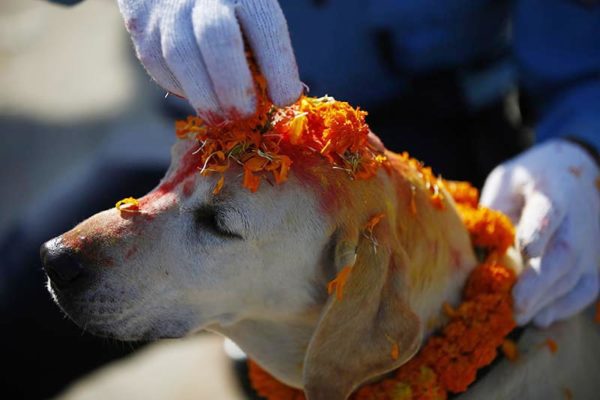
A Nepali police personnel worship a dog on the occasion of Kukur Tihar Photo: Skanda Gautam
If you have only heard the famous saying ‘Every dog has its day’, you can literally see it happen in Nepal. Festivals are the immense part of Nepali life and culture which includes both humans and animals.
Known as the festival of lights and the worship of Yama (the god of death), Tihar is also the festival where the animals are worshipped with flower garlands, fruits, sweets and showered with love and gratitude. The five days celebration starts with Kaag Tihar, the worship of Crow as the messenger of Yama followed by Kukur Tihar, the worship of dogs as the agents of Yama; Gai Tihar, the worship of cow and Govardhan Puja, the worship of oxen.
Nepalese worship Goddess Laxmi on the same day as Gai Tihar, also known as Laxmi Puja and sisters pray for the long life of their brothers on the last day of Tihar, Bhaitika.
Mha Puja, love your inner-self
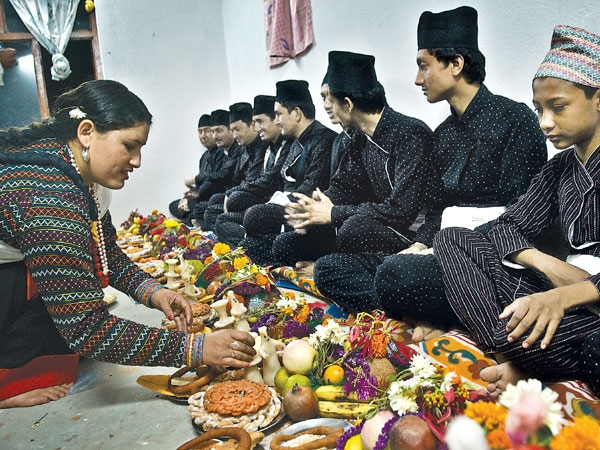
While the other days and festivals teach you to love and respect every being around you, you should not forget to count yourself in. Celebrated on the fourth day of Tihar, Mha Puja is an annual ritual performed by Newar community. ‘Mha’ meaning body in Newari language and ‘Puja’ meaning the process of worshipping, Mha Puja literally stands for the worship of inner-self.
A row of mandalas are drawn on the floor for each member of the family and the members sit crossed-legged in front of each of those. The whole procession is led by the leading lady of the family and the members follow their elders. Ittah (hand-woven cotton lights soaked in oil) is lightened up and Fruits, Dahi (Curd), Boiled Eggs, Aila (home-made alcohol), flower garlands are offered to the mandala and to own self which signifies the purification of body and soul from evil and prayer for good health thereafter.
The procession signifies self-love and self-care and celebrates the existence of owns life and its importance.
Newars ,a community where girls marry thrice
If you are wondering if it is true, then YES it is and before you think further NO, the community doesn’t encourage polyandry. Practiced since generations, the girls in Newar community marry thrice: with immortals before her menstruation and with a mortal when she grows older.
Ihee or Bel Bibah:

A girl holding Bel (a wooden apple fruit) during the Ihee ceremony in Ktm Photo Credit: Chandra Chakradhar
Known as Ihee in the Newar community, it is a ceremony in Newari community of Nepal in which pre-adolescent girls are married to the fruit called Bel (also known as a wooden apple), from which the name Bel Bibaha is derived. The fruit is bridegroom that symbolizes the eternal bachelor Lord Kumar, the son of Lord Shiva, and the marriage ensures that the girl becomes and remains fertile. The tradition of Bel Bibaha is believed to be started after a raid by Shamsuddhin Ilyas- a warlord from Bengal, during the 14th century. The invading force sacked the land, burnt palaces, looted temples, killed men and boys, dishonored girls but left married women alone. This led people to believe that marrying pre-puberty girls would save them from dishonor in any future raid.
Barah or Surya Bibaha:
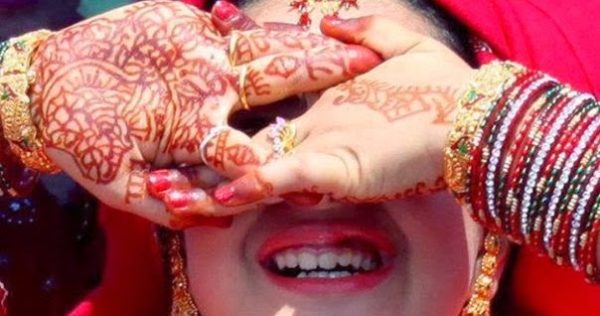
Young girl taking her first glimpse of the sun on the twelfth day of Barah
The second marriage ceremony is done with the Sun god. Barah, in the nepali language means twelve days. The girls are supposed to spend 12 days inside a room hidden from the male members of the family and the sun. However, the female members and young boys who haven’t been through Bratabandha ceremony can visit the girl. The mother and Gufa Pasa (a friend who stays with her as caretaker) takes care of her food, toiletry and other needs. On the twelfth day, the marriage ceremony takes place where girl is brought out of the room dressed as the bride and the ritual starts. Both of these marriages with immortals ensure that the newari girls are never widowed which also links with the story that she won’t have to go for Sati (a historical practice where widows were supposed to burn alive in the cremation of their husband).
Marriage with a mortal:
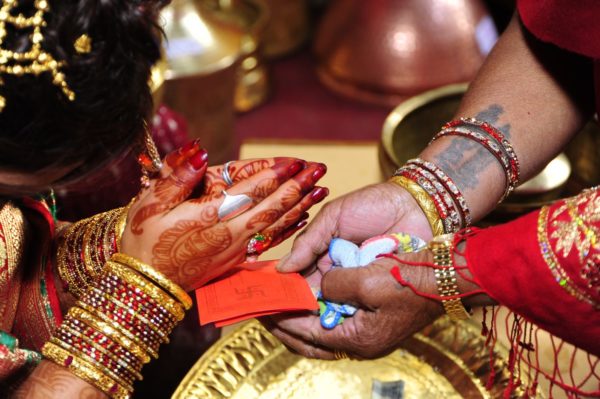
The relative giving gifts to the bride
The third marriage is similar to the normal marriage ceremonies where bride and grooms marry each other. The marriage takes place among the family and relatives of both bride and groom with rituals like Sagun (where the groom’s family visits with fruits, sweets, clothes and jewelries and confirms the marriage), Swoyambar (engagement), Gwe-saleu (ceremony where the bride leaves her parental home and thanks them for everything with betel nuts as her last gift before she goes) and other rituals.
Raute Community, the last nomads of Nepal
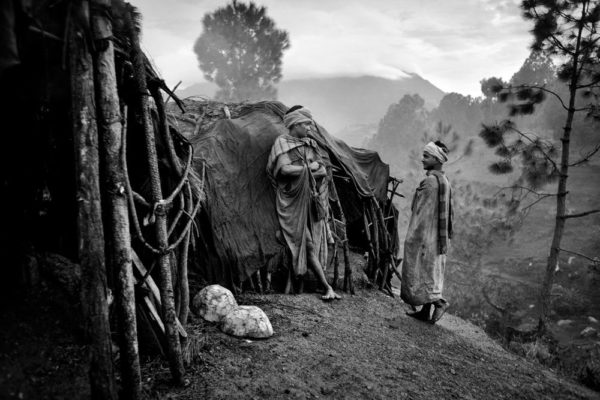
Photo Credit: Kishor Sharma
A part of Nepal least spoken about are the last of nomads in Nepal, the Raute community. Living in the remote part of western Nepal, Rautes are the indigenous ethnic group of Nepal who makes their living by the means of hunting, exploiting forest resources and bartering their wooden products for food grains.
Proud of their heritage, the last hunting-gathering community worships Bhuyar, the god of hunting and prefers to keep moving its settlement. The community divides the labour on the basis of gender and believes ‘it is a sin to sow seed’. It follows nuclear family structure and strictly prohibits polygamy, child marriage and inter-caste marriage. The widowed man can remarry, however, it is not allowed for the widow.






